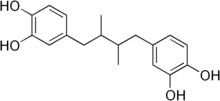
| |
| Names | |
|---|---|
| IUPAC name 4,4'-(2,3-Dimethylbutane-1,4-diyl)dibenzene-1,2-diol | |
| Identifiers | |
| CAS Number | |
| 3D model (JSmol) | |
| ChEBI | |
| ChEMBL | |
| ECHA InfoCard | 100.007.185 |
| IUPHAR/BPS | |
| MeSH | Nordihydroguaiaretic+acid |
| PubChem CID | |
| UNII | |
| CompTox Dashboard (EPA) | |
SMILES
| |
| Properties | |
| Chemical formula | C18H22O4 |
| Molar mass | 302.370 g·mol |
| Except where otherwise noted, data are given for materials in their standard state (at 25 °C , 100 kPa).
| |
Nordihydroguaiaretic acid (NDGA) is a classic lignan, a phenylpropane dimer linked by a bond between positions C8 and C8′, as opposed to a neolignan. It is a natural compound found in the creosote bush (Larrea tridentata).
Medical properties
As a lignan, it is a member of one of the major classes of phytoestrogens. While it is commonly asserted that the biological properties of lignans per sé are void, and that only the enterolignans enterodiol and enterolactone, produced from lignans by intestinal bacteria have interesting biological properties, nordihydroguaiaretic acid has antioxidant and anti-inflammatory properties in vitro or in animal models. It is a redox-type inhibitor of 5-lipoxygenase.
A 1986 study involved feeding female mosquitos NDGA to test the effect on their average lifespan. While the usual mosquito life span was 29 days, the NDGA-fed mosquitos lived an average of 45 days—an increase of 50 percent. A 2008 study reported that nordihydroguaiaretic acid lengthened the lifespan of male mice, but not of female mice.
The creosote plant has been used in herbal medicine, but its use is controversial. It was widely used during the 1950s as a food preservative and to preserve natural fibers, but was later banned after reports of toxicity during the early 1960s. Recently, it has been used as a nutritional supplement; however, renal toxicity and hepatotoxicity are reported for chronic use of creosote bush and NDGA.
See also
- Masoprocol, an antineoplastic drug used to treat skin growths caused by sun exposure.
References
- Clavel, Thomas; Henderson, Gemma; Alpert, Carl-Alfred; Philippe, Catherine; Rigottier-Gois, Lionel; Doré, Joël; Blaut, Michael (October 2005). "Intestinal Bacterial Communities That Produce Active Estrogen-Like Compounds Enterodiol and Enterolactone in Humans". Applied and Environmental Microbiology. 71 (10): 6077–6085. Bibcode:2005ApEnM..71.6077C. doi:10.1128/aem.71.10.6077-6085.2005. PMC 1265965. PMID 16204524.
- Wang, Liang; Li, Lin; Quan, Mo-Yuan; Wang, Dong; Jia, Zhen; Li, Zhen-Fei; Li, Bin; Guo, Li; Tan, Guo-Jun (May 2018). "Nordihydroguaiaretic acid can suppress progression of experimental autoimmune encephalomyelitis". IUBMB Life. 70 (5): 432–436. doi:10.1002/iub.1739. PMID 29637686. S2CID 5010565.
- Gilbert, Nathaniel C.; Gerstmeier, Jana; Schexnaydre, Erin E.; Börner, Friedemann; Garscha, Ulrike; Neau, David B.; Werz, Oliver; Newcomer, Marcia E. (July 2020). "Structural and mechanistic insights into 5-lipoxygenase inhibition by natural products". Nature Chemical Biology. 16 (7): 783–790. doi:10.1038/s41589-020-0544-7. PMC 7747934. PMID 32393899.
- Richie Jr, J. P.; Mills, B. J.; Lang, C. A. (1986). "Dietary nordihydroguaiaretic acid increases the life span of the mosquito". Proceedings of the Society for Experimental Biology and Medicine. 183 (1): 81–85. doi:10.3181/00379727-183-42389. PMID 3749035. S2CID 45324341.
- Strong, R.; Miller, R. A.; Astle, C. M.; Floyd, R. A.; Flurkey, K.; Hensley, K. L.; Javors, M. A.; Leeuwenburgh, C.; Nelson, J. F.; Ongini, E.; Nadon, N. L.; Warner, H. R.; Harrison, D. E. (2008). "Nordihydroguaiaretic acid and aspirin increase lifespan of genetically heterogeneous male mice". Aging Cell. 7 (5): 641–650. doi:10.1111/j.1474-9726.2008.00414.x. PMC 2695675. PMID 18631321.
- Arteaga, S.; Andrade-Cetto, A.; Cárdenas, R. (2005). "Larrea tridentata (Creosote bush), an abundant plant of Mexican and US-American deserts and its metabolite nordihydroguaiaretic acid". Journal of Ethnopharmacology. 98 (3): 231–239. doi:10.1016/j.jep.2005.02.002. PMID 15814253.
- Sahu, Saura C.; Ruggles, Dennis I.; O’Donnell, Michael W. (October 2006). "Prooxidant activity and toxicity of nordihydroguaiaretic acid in clone-9 rat hepatocyte cultures". Food and Chemical Toxicology. 44 (10): 1751–1757. doi:10.1016/j.fct.2006.05.016. PMID 16839654.
- Lambert, J. D.; Zhao, D; Meyers, R. O.; Kuester, R. K.; Timmermann, B. N.; Dorr, R. T. (2002). "Nordihydroguaiaretic acid: Hepatotoxicity and detoxification in the mouse". Toxicon. 40 (12): 1701–8. Bibcode:2002Txcn...40.1701L. doi:10.1016/s0041-0101(02)00203-9. PMID 12457882.